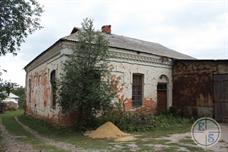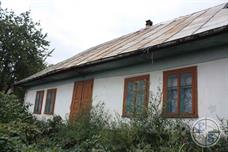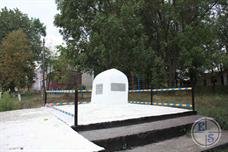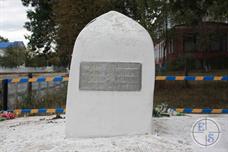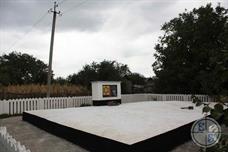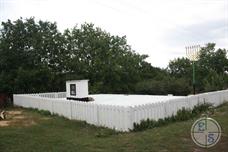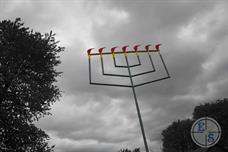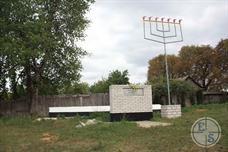Zhabokrich
Zhabokrich, 2012 г.
In 1559 the Polish king, nobles Zhabokritskim confirming their possession of "Fatherland" in Bratslav Povet, Zhabokrych mentioned among other "Villages". According to the inventory, "podymnogo tax" in 1629 there were 54 houses in Zhabokrych. By 1664, after the Polish-Cossack wars, in the village, then belonging to two owners (families and Skopovskih Bosov) had only 16 houses.
Jews settled here, probably in the first half of the XVIII century. In 1765 there were six Jewish homes in Zhabokrych, more than forty Jews living in the village, have been attributed to the community Myastkovki. According to Census 1790, there were numbered 55 Jewish settlement by this time acquired the status of town with a name change to Zhabokrych Veľký (Big).
In 1853, the community owned a wooden synagogue in which there were 120 parishioners, while it was "spiritual" Rabbi Mordechai (Mortka) Shaiman, Gabala and cantor. In the town I lived a so-called Zemsky, or "bureaucratic", Rabbi Mordechai (Mortka) Feldman.
In 1852 there were seven in Zhabokrych registered artisans Jews; in 1871, according to the governor of Podolsk, 357 inhabitants Zhabokrych was attributed to the trading estate, and 3750 - to the village, in the village there were 679 houses. In the first half of the 1890s. in the village was 440 yards, there were 4790 people in them. Jews made up more than 25% of the population and contained two prayer houses (in 1889 - 1393 Jews). In 1901, Rabbi Zhabokrych became p. Son Nathan p. Baruch Stanislavsky (born in 1872). At the beginning of the century at the disposal of the community it had three synagogue buildings.
Jews settled here, probably in the first half of the XVIII century. In 1765 there were six Jewish homes in Zhabokrych, more than forty Jews living in the village, have been attributed to the community Myastkovki. According to Census 1790, there were numbered 55 Jewish settlement by this time acquired the status of town with a name change to Zhabokrych Veľký (Big).
In 1853, the community owned a wooden synagogue in which there were 120 parishioners, while it was "spiritual" Rabbi Mordechai (Mortka) Shaiman, Gabala and cantor. In the town I lived a so-called Zemsky, or "bureaucratic", Rabbi Mordechai (Mortka) Feldman.
In 1852 there were seven in Zhabokrych registered artisans Jews; in 1871, according to the governor of Podolsk, 357 inhabitants Zhabokrych was attributed to the trading estate, and 3750 - to the village, in the village there were 679 houses. In the first half of the 1890s. in the village was 440 yards, there were 4790 people in them. Jews made up more than 25% of the population and contained two prayer houses (in 1889 - 1393 Jews). In 1901, Rabbi Zhabokrych became p. Son Nathan p. Baruch Stanislavsky (born in 1872). At the beginning of the century at the disposal of the community it had three synagogue buildings.
Almost all areas of the economic life of the town - a craft, industrial and commercial - in the hands of the Jews. Jews rented the largest enterprise - distillery (founded in 1860), owned by one of the two steam mills, mёdovarennym plant, timber yards, as well as all the shops and stores, a total of about forty.
Jewish pogroms of the time of the collapse of the empire did not pass Zhabokrych. In the Orthodox feast of the (November 1917), a group of young peasants came to town and beat the Jews with iron bars.
28 - August 30, 1919 soldiers of the retreating army units Directories staged in the town mayhem.
At the beginning of the 1920s. Zhabokrych was a medium-sized town with 8000 inhabitants. Jews accounted for a quarter of its population and living compactly in the center of town; most of the Jewish population were craftsmen: shoemakers, furriers, carpenters, blacksmiths.
Rabbi Zhabokrych r.Natan Stanislavsky remained until the 1920s. he did not come to the conclusion that "the place is no longer in need of a rabbi, because to him no one goes." For some time continued to operate four header, the summer of 1923, two of them were closed, remaining engaged and fifty children. . Due to the financial difficulties of a Jewish school opened in the early 1920s, it was forced to close; children's home of the scarcity of funds located in two rooms of an apartment house where the acute shortage of staff. He was kept at the expense of Evobschestkoma and "Joint", and from May 1923 - only at the expense of the latter, as the Board of Education refused to support him.
Part of the Jewish youth was swept Komsomol work which was conducted in Yiddish, among 16 local Komsomol were 12 Jews.
In 1923, 823 Jews lived here (20% of the population).
Jewish pogroms of the time of the collapse of the empire did not pass Zhabokrych. In the Orthodox feast of the (November 1917), a group of young peasants came to town and beat the Jews with iron bars.
28 - August 30, 1919 soldiers of the retreating army units Directories staged in the town mayhem.
At the beginning of the 1920s. Zhabokrych was a medium-sized town with 8000 inhabitants. Jews accounted for a quarter of its population and living compactly in the center of town; most of the Jewish population were craftsmen: shoemakers, furriers, carpenters, blacksmiths.
Rabbi Zhabokrych r.Natan Stanislavsky remained until the 1920s. he did not come to the conclusion that "the place is no longer in need of a rabbi, because to him no one goes." For some time continued to operate four header, the summer of 1923, two of them were closed, remaining engaged and fifty children. . Due to the financial difficulties of a Jewish school opened in the early 1920s, it was forced to close; children's home of the scarcity of funds located in two rooms of an apartment house where the acute shortage of staff. He was kept at the expense of Evobschestkoma and "Joint", and from May 1923 - only at the expense of the latter, as the Board of Education refused to support him.
Part of the Jewish youth was swept Komsomol work which was conducted in Yiddish, among 16 local Komsomol were 12 Jews.
In 1923, 823 Jews lived here (20% of the population).
German troops entered Zhabokrych in the 20 days of July 1941, after the Romanian occupation regime has been established here. Until the end of July the Romanian gendarmes completely destroyed the Jewish population of the town. Jews pushed into the cellar and shot them in the back. Separate the wounded subsequently managed to get out and escape.
Now the Jews did not live Zhabokrych
V.Lukin, "100 Jewish settlements in Ukraine"
Now the Jews did not live Zhabokrych
V.Lukin, "100 Jewish settlements in Ukraine"
Vinnitsa Region

My shtetl
My shtetl
Jewish towns of Ukraine
Jewish towns of Ukraine
